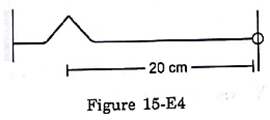A string of linear mass density 05 g cm−1 and a total length 30 cm is tied to a fixed wall at one end and to a frictionless ring at the other end (figure 15-E4). The ring can move on a vertical rod. A wave pulse is produced on the string which moves towards the ring at a speed of 20 cm s−1. The pulse is symmetric about its maximum which is located at a distance of 20 cm from the end joined to the ring. (A) Assuming that the wave is reflected from the ends without loss of energy, find the time taken by the string to regain its shape. (B) The shape of the string changes periodically with time. Find this time period. (C) What is the tension in the string?

A. 2 s
To regain its shape, it need to go to the end and then to come back to that position. In this whole process the total distance covered is (20+20) cm=40cm
So, the time needed will be,
![]()
![]()
![]()
B. 3 s
The string comes to its original shape after completing a whole cycle. This required (30+30) cm = 60cm.
So, the time needed will be,
![]()
![]()
![]()
C. 2 × 10−3 N
To find the tension we will use the expression of velocity.
![]()

![]()
![]()
![]()